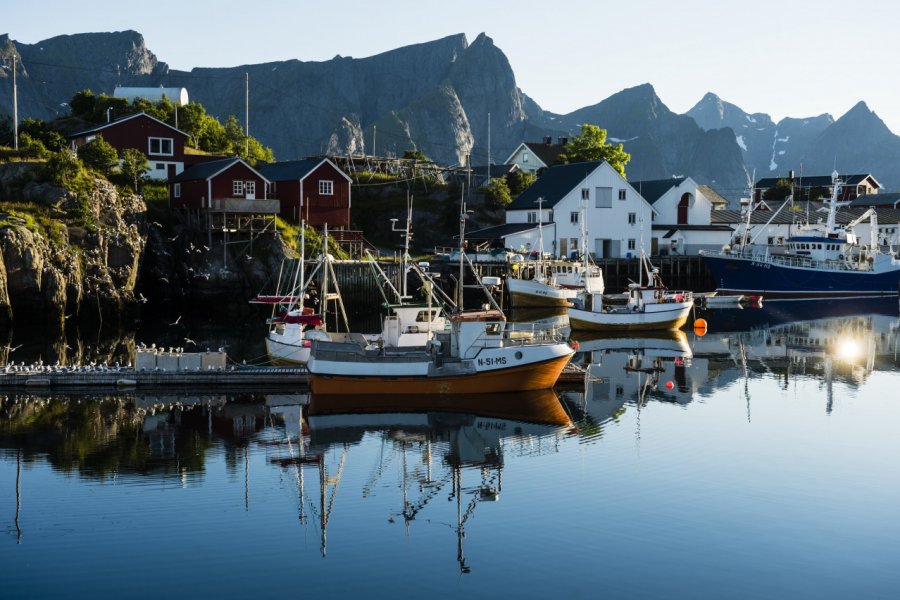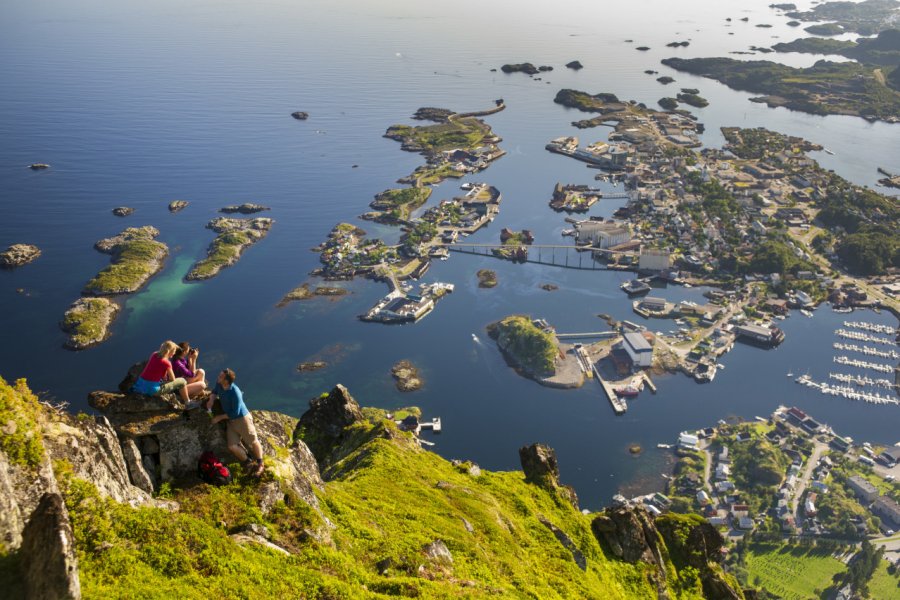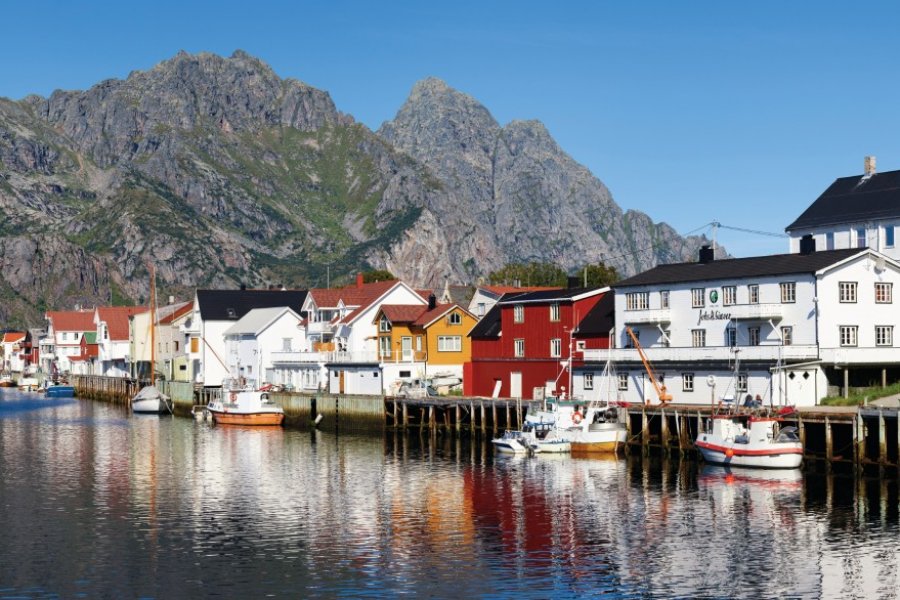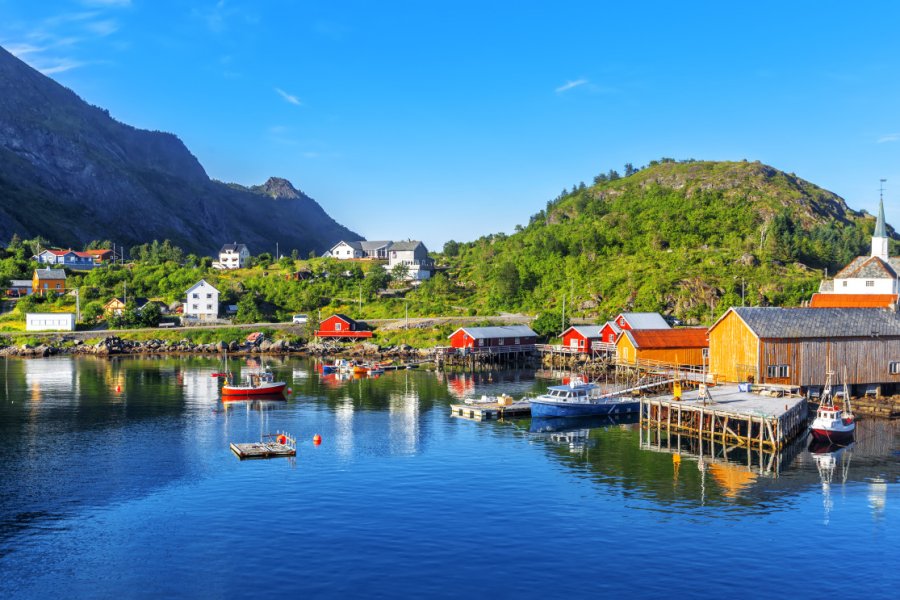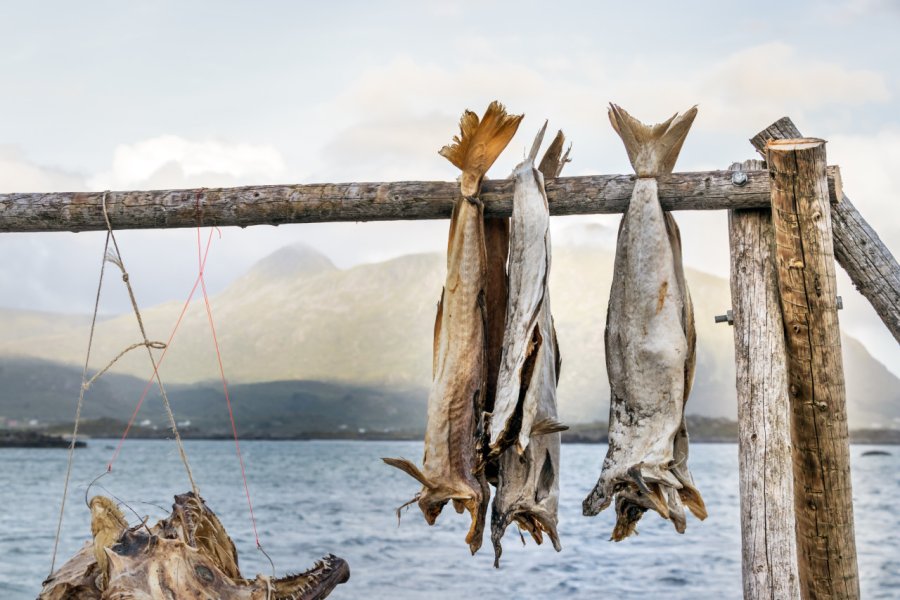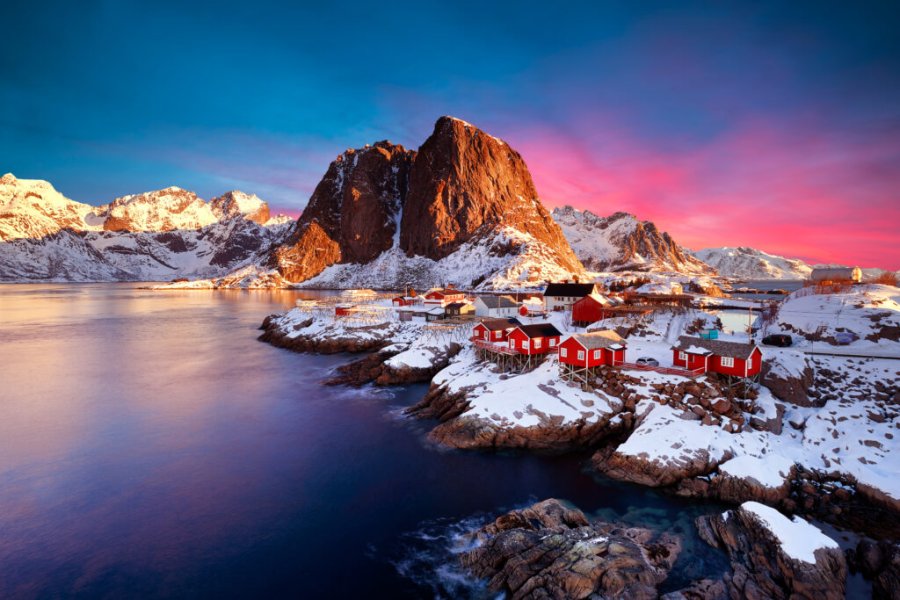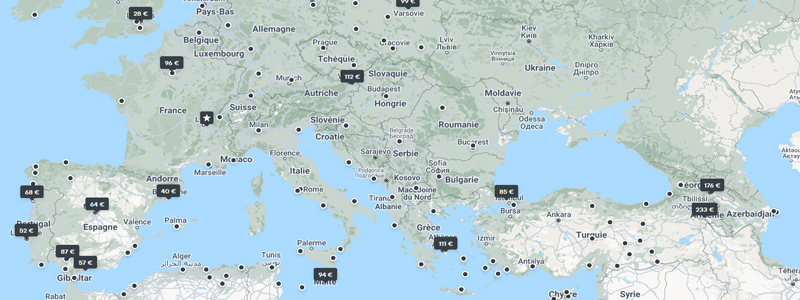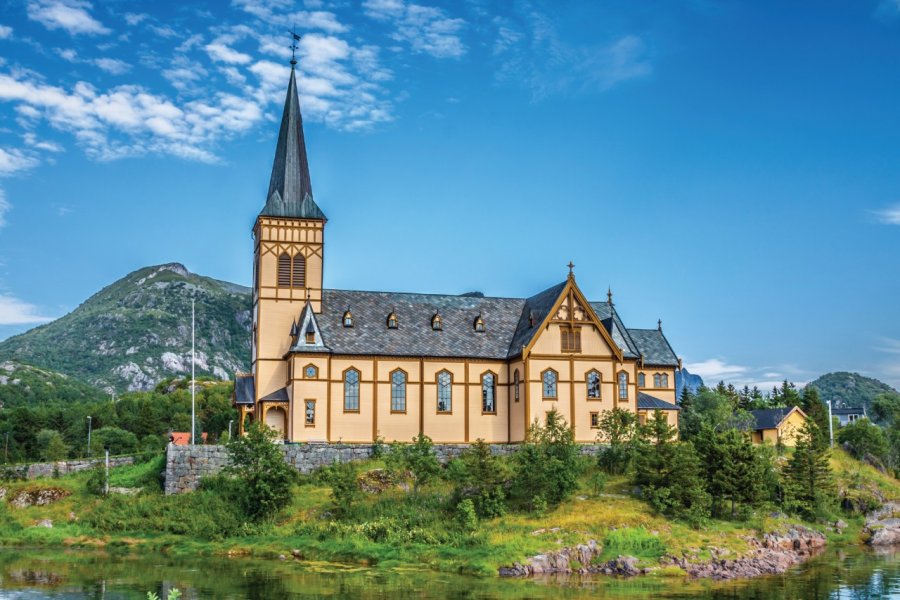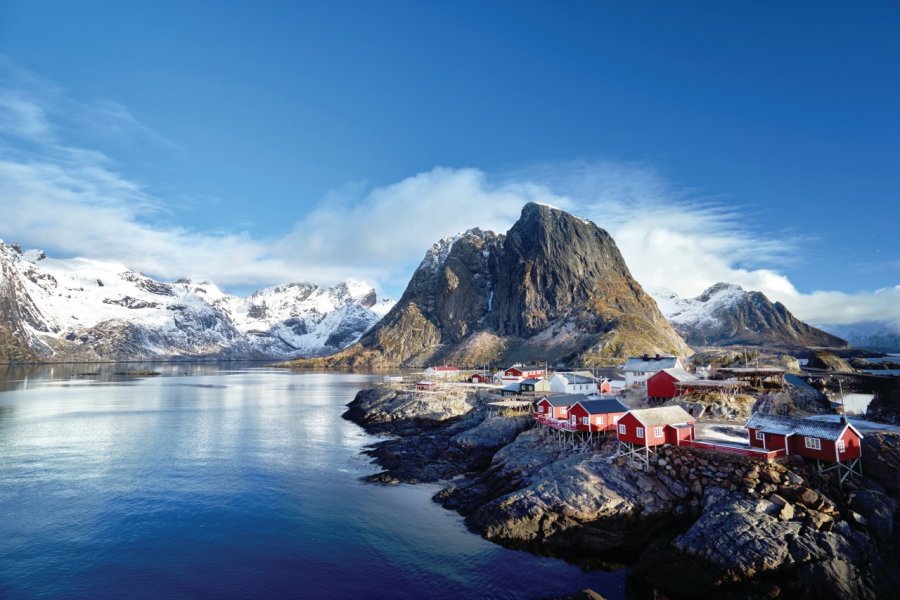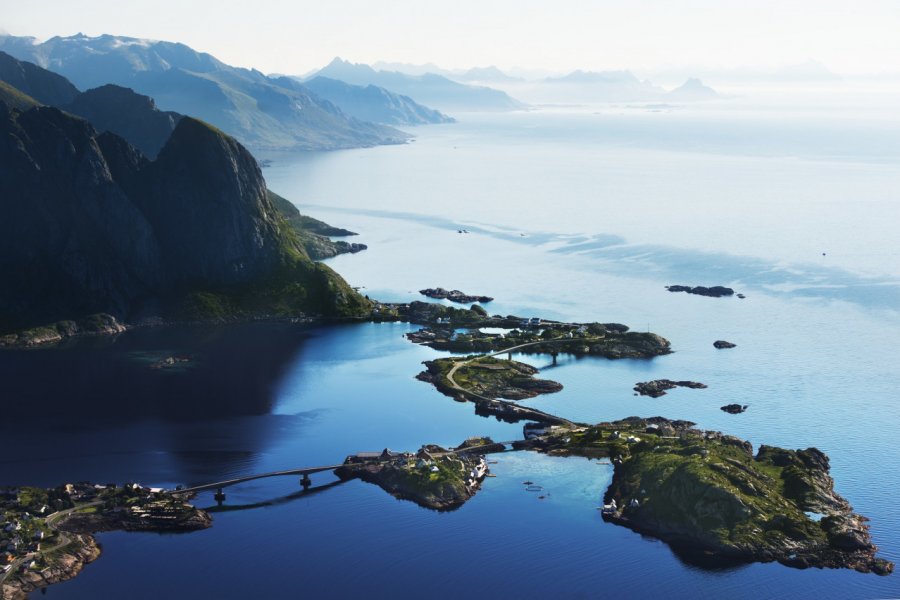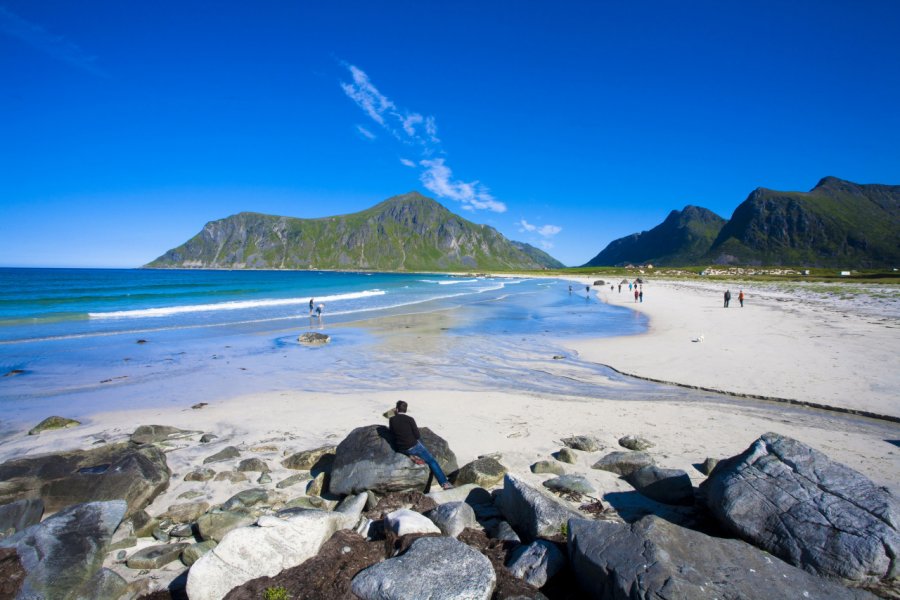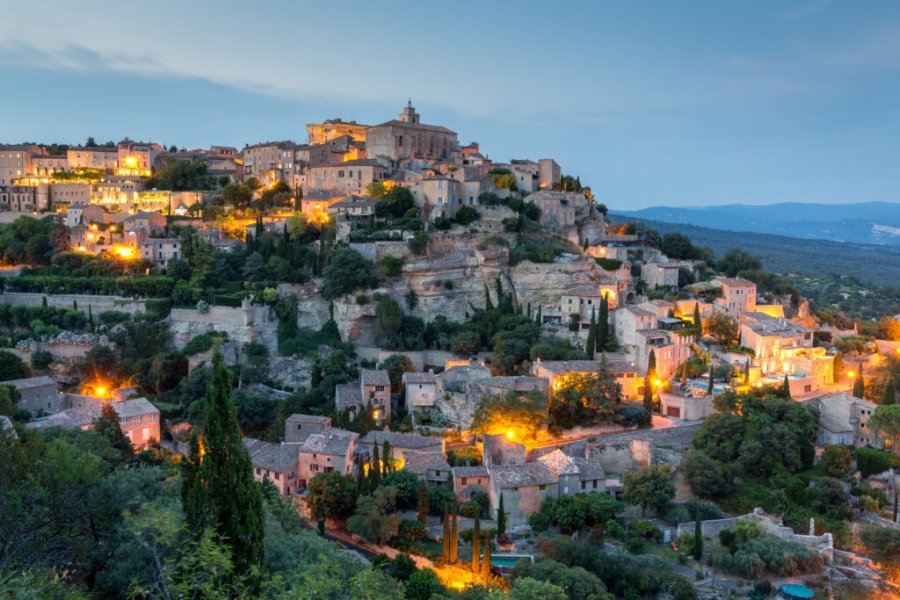Travel Guide Iles Lofoten
The Lofoten Islands form a chain of islands stretching between the 67th and 68th parallel north. They form an archipelago of 1,227 km² in Norway's Nord-Norge region. These islands are living witnesses to centuries of history and unspoiled nature. Fishing, an ancestral activity, continues to be celebrated here, notably through the miraculous fishing of Norwegian Arctic cod from January to April.
The etymological root of the name Lofoten - Ló meaning lynx and Fótr foot in ancient Scandinavian - suggests the animal form of these islands. And the famous fishermen's huts, the rorbus populate these lands, recalling an immemorial tradition.
The landscape of the Lofoten Islands is a living tableau of deep fjords, steep cliffs, fertile plains and white sandy beaches. The small ports, with their fishermen's huts on stilts, add a colorful touch to the scenery. The play of light is sublime! They range from pink to glowing red, from incandescent to azure, giving the islands an irresistible charm. Bunes Beach is a haven of peace, with its fine sand and crystal-clear waters. The Lofoten Aquarium unveils the richness of local marine life, a veritable window on the ocean. Then, history comes to life at the Lofotr Viking Museumwhere you can immerse yourself in the daily life of the Vikings, between reconstructions and archaeological discoveries. The Trevarefest in Tuva is a vibrant celebration of local culture. Last but not least, Uttakleiv Beachoften cited as one of the most beautiful beaches in the world, offers breathtaking panoramas, especially at sunset.
In the heart of the Lofoten Islands, a constellation of islands sparkles: Austvågøy, Gimsøy, Vestvågøy, Flakstadøy, Moskenesøy, Vaerøy, and Røst, not forgetting the southern part of Hinnøy, Norway's giant. And what better way to discover them than by taking the E10 road, a ribbon of asphalt that winds happily for 170 km from Fiskebøl to Å? This road is an invitation to adventure. It takes you through a dazzling ballet of landscapes: sometimes skirting dark mountains, sometimes flirting with their green sisters, populated by mischievous goats. It guides you along coasts resembling Caribbean paradises, over majestic fjords and through picturesque villages where time seems to stand still.
Artists such as Kaare Espolin Johnson, the famous 20th-century painter, have found the Lofoten an inexhaustible muse. Their works, exhibited notably at the Kabelvåg gallery, are windows onto the soul of these islands. The Lofoten Islands also offer a variety of activities: whale and orca safaris, fishing, hiking, kayaking and cultural visits. Nordic Safari Wildlife Adventures offers epic wildlife safaris.
The discovery of oil offshore has been the subject of national debate, but the Norwegian government has chosen to preserve these islands, banning all offshore oil activity.
The Lofoten Islands, with their natural charm, stunning scenery and deep-rooted culture, are a must-see destination for any travel guide. To make the most of it, visit the most beautiful sites, sample local dishes in the best restaurants and discover incredible accommodations such as a typical rorbu converted into a cosy chalet. This archipelago propels you into a world where nature reigns supreme, revealing to globetrotters an authentic and unforgettable getaway.
What to visit dans les Iles Lofoten?
When to go to dans les Iles Lofoten?
When should you visit Norway's Lofoten Islands? The archipelago is bathed by the waters of the Atlantic Ocean and boasts an astonishing panorama: rugged mountains, deep fjords and picturesque fishing villages. Each season reveals a different face, as charming as it is surprising! Here are our smart recommendations:
Spring (March to May): the days get longer, the snow melts slowly and reveals pretty meadows. It's the perfect time for hiking and photography, with low rates before high season. The northern lights are still visible in early spring, making for a magical night-time spectacle!
Summer (June to August): the midnight sun bathes the Lofoten Islands in golden light almost 24/7. This is the high season: prices are higher, but the weather is ideal for kayaking, hiking and fishing. Villages come alive, cultural festivals are in full swing, and marine life is at its peak.
Autumn (September to November): fewer tourists, more attractive prices and a peaceful atmosphere make autumn an ideal time to recharge your batteries. It's also the return of the northern lights, which begin to illuminate the starry nights.
Winter (December to February): a must for fans of winter sports and the Northern Lights, the climate is harsh, but the beauty of the snow-covered landscapes is unrivalled. Prices are more affordable, and the experience, though more demanding, is absolutely unique.
So the best time to go to the Lofoten Islands depends on what you're looking for. For summer adventures under the midnight sun, prefer June to August. If you're fascinated by the northern lights and wintry landscapes, December to February will be your preferred period.
Weather at the moment
The weather on the Lofoten Islands is quite an adventure! The climate of the Lofoten Islands is subarctic, which means mild summers and cold winters, but not extreme ones, just the song of the waves and the whisper of the wind. Whether you're here for the balmy summer weather or the winter chill, the Lofoten Islands never fail to amaze!
Spring (March to May): the weather on the Lofoten Islands starts to warm up. The days get longer and temperatures rise slowly. This is the low season.
Summer (June to August): the high season is in full swing. Temperatures are pleasant, perfect for hiking under the midnight sun.
Autumn (September to November): the weather in Lofoten cools down, making this the ideal season for tranquillity and the beauty of the Northern Lights.
Winter (December to February): get your down jackets ready! Temperatures plummet, but the magic of the Northern Lights and snow-covered landscapes more than make up for it. It's low season, but what a season!
Narvik
Budget for the Lofoten Islands: for this far-north getaway, the Lofoten Islands are a bit pricey, but with a bit of savvy, they're accessible to all wallets. The Norwegian krone is the currency of the game here, and you'll have no trouble finding ATMs in the villages. Credit cards? Accepted almost everywhere!
In Norway, tipping is not really a way of life. A little extra for exceptional service is always appreciated, but not obligatory. If you're the thrifty type, don't panic! The Lofoten Islands offer affordable accommodation, from youth hostels to campsites with breathtaking views. Looking for a little more comfort? Discover charming B&Bs and hotels that combine comfort and authenticity. And if you're looking to treat yourself, there's no shortage of luxury, with top-of-the-range chalets and boutique hotels, perfect for immersing yourself in the Arctic atmosphere!
The Lofoten Islands are a bit like a Norwegian buffet: there's something for every taste and budget! Get ready to fall in love with this corner of paradise, whatever your wallet.
Good news for EU citizens: no visa is required for the Lofoten Islands! A valid passport or identity card is all you need to enter Norway and discover the splendors of the Lofoten Islands. For travelers from other countries, visa requirements for the Lofoten Islands depend on agreements with Norway. Check with the Norwegianembassy or consulate in your country for specific requirements.
For short stays, generally up to 90 days, a Schengen visa is required for nationals of countries outside the Schengen area. This will enable you to travel not only within Norway, but also to other Schengen countries. For longer stays, or for specific reasons such as work or study, other types of visa may be required.
To make your Lofoten Islands adventure unforgettable, a few health tips are in order. No specific vaccinations are necessary, just check that your usual vaccinations are up to date and consult a health professional before you leave, especially if you have any specific health needs or pre-existing conditions. As for drinking water, it's of the highest quality in Norway. Fresh and pure, Norwegian mountain water is a real pleasure to drink. And don't forget to pack a first-aid kit, especially if you're planning more adventurous hikes or excursions.
Practical information
- When to travel?
- Weather forecast
- Budget
- Formalities
- Health
- How to travel by yourself?
- How to get organized?
- Getting around
Media
How to go to dans les Iles Lofoten? Our advice & tips
An organized trip to the Lofoten Islands is a getaway where everything is taken care of, from exploring majestic fjords to discovering colorful fishing villages. Here are a few ideas for organized trips and tips on how to make the most of them.
Adventure and nature tour: this type of trip includes guided hikes in the mountains, kayaking along the fjords, and a whale-watching boat trip.
Cultural tour : discover the heritage of the Lofoten Islands through visits to local museums, workshops in traditional Norwegian cuisine, and evenings of storytelling and local legends.
Photo trip: with a professional photographer, explore the islands' most photogenic spots to capture the Northern Lights or the sublime sunset landscapes.
Tips: check cancellation policies and take out travel insurance for peace of mind!
Going to the Lofoten Islandsalone means opting for a unique adventure in the heart of Norway. Here are a few tips:
Select youth hostels or couchsurfing sites for more authentic experiences and rewarding encounters.
Rent a bike or car to explore the islands at your own pace. This gives you total freedom to explore spots off the beaten track.
Visit local markets to sample regional specialties.
Cook for yourself - it's economical and immerses you in the local culture!
Strike up a conversation with the locals. They can share valuable tips and fascinating stories about their region.
Don't miss the hikes - they offer spectacular views. Always keep a map and phone charged.
These tips will turn your trip to the Lofoten Islands into an authentic globetrotting experience.
There are several options for getting around the Lofoten Islands in Norway:
Renting a car is the most flexible option for exploring Lofoten. The roads are well maintained and offer magnificent views. However, beware of weather conditions, which can change rapidly.
The bus network serves most of the islands' towns and villages.
Ferries link the various islands, and some carry cars.
Renting a bike is an excellent way to get around, especially in summer.
Hiking is an ideal way to explore the wild beauty of Lofoten.
We recommend planning your excursions in advance, especially in high season, as transport options can be limited and in high demand.
dans les Iles Lofoten travel inspiration
Find unique Stay Offers with our Partners
Pictures and images des Iles Lofoten
Discover les Iles Lofoten
When should you visit Norway's Lofoten Islands? The archipelago is bathed by the waters of the Atlantic Ocean...
Read more about it
The weather on the Lofoten Islands is quite an adventure! The climate of the Lofoten Islands is subarctic Read more about it
Budget for the Lofoten Islands: for this far-north getaway, the Lofoten Islands are a bit pricey, but with a b...
Read more about it
Good news for EU citizens: no visa is required for the Lofoten Islands! A valid passport or identity card <...
Read more about it
To make your Lofoten Islands adventure unforgettable, a few health tips are in order. No specific vacci...
Read more about it
Going to the Lofoten Islandsalone means opting for a unique adventure in the heart of Norway. He...
Read more about it
An organized trip to the Lofoten Islands is a getaway where everything is taken care of, from exploring majest...
Read more about it
There are several options for getting around the Lofoten Islands in Norway:
Renting a car is the most fl...
Read more about it
